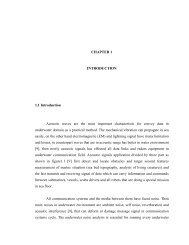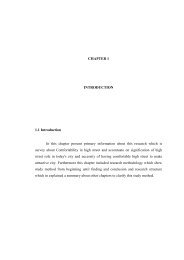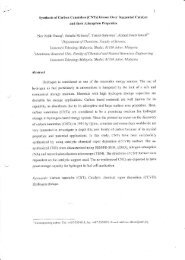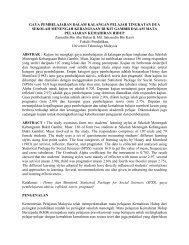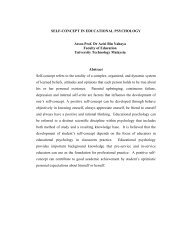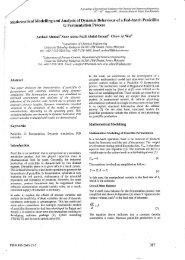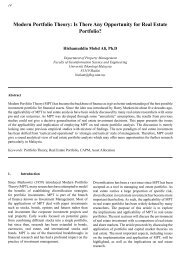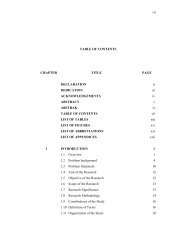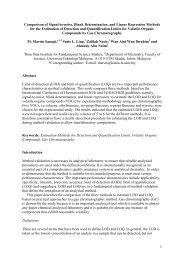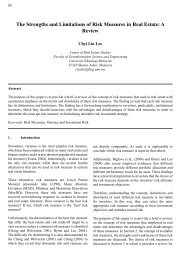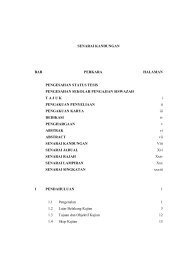Rational approach to the selection of conditions for diastereomeric ...
Rational approach to the selection of conditions for diastereomeric ...
Rational approach to the selection of conditions for diastereomeric ...
You also want an ePaper? Increase the reach of your titles
YUMPU automatically turns print PDFs into web optimized ePapers that Google loves.
F. C. Ferreira et al. / Tetrahedron: Asymmetry 17 (2006) 1337–1348 1343<br />
Model outputs<br />
-Yield<br />
-Solid e.e.<br />
-Mo<strong>the</strong>r liquor e.e<br />
-Mo<strong>the</strong>r liquor pH<br />
ASR<br />
R t , S t<br />
Model parameters:<br />
-K s AS , K s AR , K s AR2 , K s<br />
AS2<br />
Model input variables:<br />
[A] 0 , [S] 0 , [R] 0<br />
S t<br />
AS 2<br />
Kd 1’S<br />
2 × S t<br />
Kd 2S<br />
A t<br />
2 × R t<br />
Kd 2R<br />
R t<br />
AR 2<br />
Kd 1’R<br />
AS<br />
S t<br />
R t<br />
AR<br />
Kd 1S<br />
Kd 1R<br />
Figure 5. Equilibria considered in model I, which neglects acid–base equilibrium.<br />
ASR<br />
Model outputs<br />
Model parameters:<br />
-Yield<br />
-Kd 1 ,Kd 2<br />
-Solid e.e.<br />
-Mo<strong>the</strong>r liquor e.e<br />
-Ka 1 ,Ka 2 ,Ka amine K w<br />
-K AS s , K AR s , K AR2 AS2<br />
s , K s<br />
AS A 2- 2 AR 2<br />
SH + H + Kd 2S<br />
H + Kd 2R<br />
RH + H +<br />
pH ~ pKa 2<br />
-Mo<strong>the</strong>r liquor pH<br />
Model input variables:<br />
RH + , SH + [A] 0 , [S] 0 , [R] 0<br />
2 × SH +<br />
2 × RH +<br />
Kd 1’S SH +<br />
RH +<br />
Kd 1’R<br />
AS<br />
HA -<br />
AR<br />
Kd 1S<br />
H +<br />
Kd 1R<br />
pH ~ pKa 1<br />
H 2 A<br />
R<br />
S<br />
H + H +<br />
RH +<br />
SH +<br />
pH ~ pKa amine<br />
Figure 6. Equilibria considered in model II, which takes in<strong>to</strong> account acid–base equilibrium.<br />
3. Precipitation/crystallisation <strong>of</strong> <strong>the</strong> four <strong>diastereomeric</strong><br />
salts follows ideal behaviour and is <strong>the</strong>rmodynamically<br />
controlled, following <strong>the</strong> solubility limits <strong>of</strong> <strong>the</strong> respective<br />
<strong>diastereomeric</strong> salts (Ks AS , Ks AR , Ks AR2 and<br />
Ks AR2 ).<br />
4. The two proposed models differ in <strong>the</strong> following<br />
assumptions:<br />
(a) For model I (<strong>the</strong> simpler model) <strong>the</strong> acid–base equilibrium<br />
<strong>of</strong> <strong>the</strong> diacid resolving agent and amine<br />
enantiomers is neglected, and <strong>the</strong> <strong>diastereomeric</strong><br />
equilibrium constants are defined on <strong>the</strong> basis <strong>of</strong><br />
<strong>the</strong> <strong>to</strong>tal amount <strong>of</strong> reactants dissolved in <strong>the</strong><br />
mo<strong>the</strong>r liquor (Eqs. 8a–11a).<br />
(b) For model II (<strong>the</strong> more complex model), acid–base<br />
equilibrium are taken in<strong>to</strong> account and is assumed<br />
that <strong>the</strong> <strong>for</strong>mation <strong>of</strong> <strong>diastereomeric</strong> salts occurs<br />
through ionic bonds between <strong>the</strong> charged carboxylate<br />
groups <strong>of</strong> <strong>the</strong> diacid resolving agent and<br />
ammonium group <strong>of</strong> <strong>the</strong> amine. There<strong>for</strong>e, <strong>the</strong><br />
equilibrium constants <strong>for</strong> <strong>diastereomeric</strong> salt <strong>for</strong>mation<br />
are based only on <strong>the</strong> ionic <strong>for</strong>ms <strong>of</strong> <strong>the</strong><br />
reactants (Eqs. 8b–11b). Moreover, <strong>the</strong> acid–base<br />
equilibria <strong>for</strong> <strong>the</strong> amine and <strong>the</strong> diacid resolving<br />
agent, with <strong>the</strong> respective acid dissociation constants,<br />
are also taken in<strong>to</strong> account through Ka amine ,<br />
Ka 1 and Ka 2.<br />
5. There is no chiral recognition in solution. 16 There<strong>for</strong>e,<br />
<strong>the</strong> same value is assigned <strong>to</strong> equilibrium constants <strong>of</strong><br />
reactions in <strong>the</strong> mo<strong>the</strong>r liquid independently <strong>of</strong> <strong>the</strong><br />
enantiomer considered, that is, Kd 1S ¼ Kd 1R ¼ Kd 1 ;<br />
Kd 1 0 S ¼ Kd 1 0 R ¼ Kd 1<br />
0 and Kd 2S ¼ Kd 2R ¼ Kd 2 .<br />
6. Diastereomeric salt <strong>for</strong>mation tends <strong>to</strong>wards irreversibility<br />
and <strong>the</strong> values <strong>of</strong> <strong>the</strong> equilibrium constants were<br />
selected accordingly.<br />
7. The Gibbs free energy <strong>of</strong> bond <strong>for</strong>mation between <strong>the</strong><br />
free resolving agent and <strong>the</strong> first amine (acidic salt <strong>for</strong>mation),<br />
and <strong>the</strong> acidic salt and <strong>the</strong> second amine (<strong>for</strong>mation<br />
<strong>of</strong> <strong>the</strong> neutral salt) is <strong>the</strong> same, hence <strong>the</strong>y have<br />
<strong>the</strong> same <strong>for</strong>mation enthalpy and constants, that is,<br />
Kd 1 ¼ Kd 1<br />
0 and f = 1. Thus Kd 2 is equal <strong>to</strong> (Kd 1 ) 2 .



